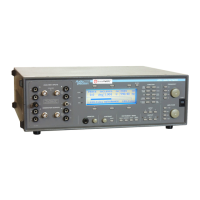The amplitude can be measured in units of V, dBV, dBu, dBm, dBr,
dBg, or W. The units are selected by the upper left soft key.
The upper right corner of the display shows the measured frequency of
the input signal, or the frequency of the bandpass filter if the
SELECTIVE filter is chosen.
The amplitude is measured using true RMS detection except in a few
of the filtering modes described below. Several types of filters may
also be applied to the amplitude measurement.
The type of filter is selected by the lower left soft key. Three types of
filters are available:
.
UN-WTD – The unweighted selection provides no filtering
except selectable bandwidth-limiting:
.
The lower center soft key selects the lower band limit
(<10 Hz, 22 Hz or 400 Hz).
.
The lower right soft key selects the upper band limit
(>300 kHz, 22 kHz, 22 kHz-QPK, 30 kHz, 80 kHz). The
22 kHz-QPK selection uses the quasi-peak detector instead
of the true RMS detector in accordance with CCIR-468.
The 22 Hz lower limit is only available if the upper limit is
22 kHz; the <10 Hz lower limit is only available with other
upper limits.
.
SELECTIVE – This selection provides a tunable bandpass filter.
The filter has a bandwidth of 1/3 octave. No other filtering is
provided. The top right corner of the display shows the filter
center frequency, which can be adjusted with the FREQUENCY
controls. The SELECTIVE filter can be used to create
spectrum-analysis sweeps. In this type of measurement, a
narrow bandpass is swept across a range of frequencies, taking
an amplitude measurement at each step.
& For a more
detailed discussion of
units, see page 3-17.
& The shapes of the
bandwidth-limiting
filters are shown on
page 1-6.
4 Functions
Amplitude FUNCTION Descriptions
4-2 ATS-1 Access User's Manual

